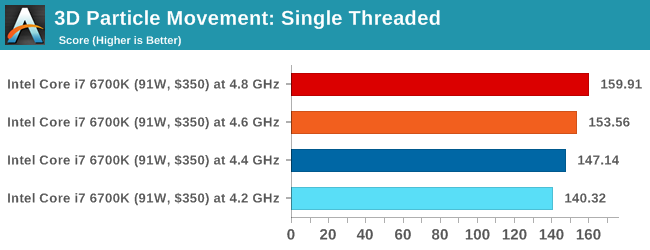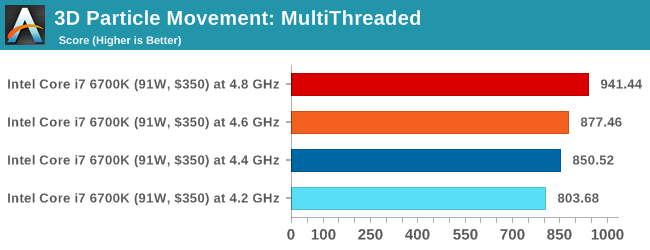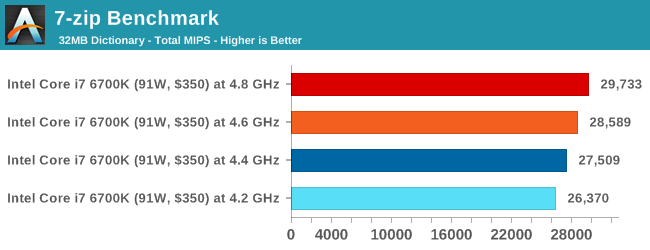The Intel Skylake i7-6700K Overclocking Performance Mini-Test to 4.8 GHz
by Ian Cutress on August 28, 2015 2:30 PM ESTCPU Tests on Windows: Office
WinRAR 5.0.1: link
Our WinRAR test from 2013 is updated to the latest version of WinRAR at the start of 2014. We compress a set of 2867 files across 320 folders totaling 1.52 GB in size – 95% of these files are small typical website files, and the rest (90% of the size) are small 30 second 720p videos.

3D Particle Movement
3DPM is a self-penned benchmark, taking basic 3D movement algorithms used in Brownian Motion simulations and testing them for speed. High floating point performance, MHz and IPC wins in the single thread version, whereas the multithread version has to handle the threads and loves more cores.


FastStone Image Viewer 4.9
FastStone is the program I use to perform quick or bulk actions on images, such as resizing, adjusting for color and cropping. In our test we take a series of 170 images in various sizes and formats and convert them all into 640x480 .gif files, maintaining the aspect ratio. FastStone does not use multithreading for this test, and results are given in seconds.

Synthetic – 7-Zip 9.2: link
As an open source compression tool, 7-Zip is a popular tool for making sets of files easier to handle and transfer. The software offers up its own benchmark, to which we report the result.

Conclusions on Office Benchmarks
Similar to the professional tests, the gains here are in-line with what we would expect with +200 MHz overclocks.










103 Comments
View All Comments
StrangerGuy - Sunday, August 30, 2015 - link
If we keep dropping the OC multi on Skylake we are going into single-digit clock increases territory from 4GHz stock :)Yeah, I wonder why AT mentioned in their Skylake review about why people are losing interest in OCing despite Intel's claims of catering to it. From the looks of it, their 14nm process simply isn't tuned for 4GHz+ operation but towards the lower clocked but much more lucrative chips for the server and mobile segment.
qasdfdsaq - Wednesday, September 2, 2015 - link
Then you are deluded. There are edge cases and scenarios that will cause a hardware crash on a Xeon server with ECC RAM at stock speeds, so by your reckoning *nothing* is ever 100% stable.danjw - Friday, August 28, 2015 - link
When can we expect a platform overview? You reviewed the i7-6700K, but you didn't have much in details about them. You were expecting that from IDF. IDF is over, so is there an ETA?MrBowmore - Friday, August 28, 2015 - link
+1hansmuff - Friday, August 28, 2015 - link
I assume the POV-Ray score is the "Render averaged PPS"?My 2600K @4.4 gets 1497 PPS, so a 35% improvement compared to 6700k @4.4
hansmuff - Friday, August 28, 2015 - link
And of course I mean the 6700k seems to be 35% faster in POV... sigh this needs an edit buttonlooncraz - Saturday, August 29, 2015 - link
POV-Ray has been seeing outsized performance improvements on Intel.From Sandy Bridge to Haswell sees a 20% improvement, when the overall improvement is closer to 13%.
HandBrake improved even more - a whopping 29% from Sandy Bridge to Haswell.
And, of course, I'm talking core-for-core, clock-for-clock.
I suspect much of this improvement is related to the AVX/SIMD improvements.
Just hope AMD focused on optimizing for the big benchmark programs as well as their server target market with Zen (this is past tense since Zen is being taped out and currently being prototyped.. rumors and some speculation, of course, but probably pretty accurate).
zepi - Sunday, August 30, 2015 - link
One has to remember, that "handbrake" doesn't actually use CPU-resources at all. The process that is actually benchmarked is running x264 codec with certain settings easily accessible by using GUI called handbrake.If x264 or x265 programmers create new codepaths inside the codecs that take benefit of new architecture, it received huge performance gains. But what this actually means is that Sandy Bridge and Skylake actually run different benchmarks with different instructions fed to processors.
Do I care? No, because I just want my videos to be transcoded as quickly as possible, but one should still remember that this kind of real world benchmarks don't necessarily run same workloads on different processors.
MrBowmore - Friday, August 28, 2015 - link
When are you going to publish the runthrough of the architechture?! Waiting impatiently! :)NA1NSXR - Friday, August 28, 2015 - link
Sigh, still no BCLK comparisons at same clocks. What would really answer some unanswered questions would be comparing 100 x 40 to 200 x 20 for example.